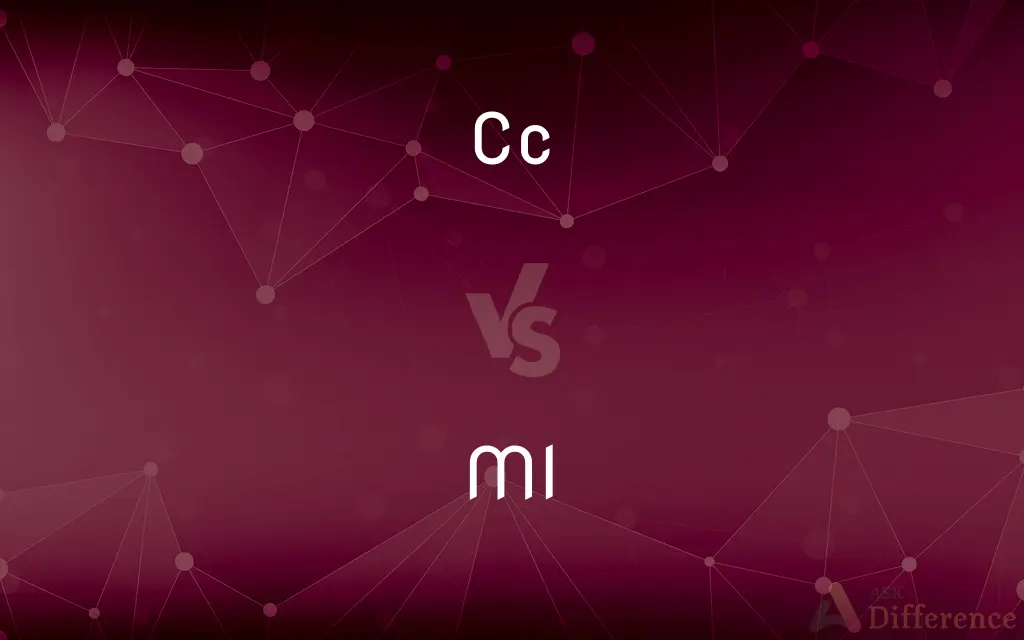CC vs. ML — What's the Difference?
By Maham Liaqat & Urooj Arif — Updated on March 16, 2024
CC (cubic centimeters) and mL (milliliters) are both units of volume, with 1 cc exactly equal to 1 mL in measurement.

Difference Between CC and ML
Table of Contents
ADVERTISEMENT
Key Differences
CC, or cubic centimeters, is a unit of volume often used in the medical and automotive fields to denote the volume of fluids or engine displacement. Whereas, mL, or milliliters, is commonly used in cooking, science, and medicine to measure liquid volumes.
Although cc and mL are equivalent in volume, cc is more frequently used in contexts requiring precision, such as in medical dosages and engine sizes, while mL is preferred in general scientific and culinary measurements.
The choice between cc and mL often depends on the traditional practices of specific fields or regions. For example, the medical field in some countries might prefer cc for its historical usage, whereas mL is widely adopted in scientific and culinary contexts globally.
Understanding the interchangeability of cc and mL is crucial, especially in fields like medicine where precise measurements are essential for dosages and treatments.
Despite their equivalence, the use of mL is encouraged by international standards organizations, such as the International System of Units (SI), to maintain consistency in measurements across various scientific and professional fields.
ADVERTISEMENT
Comparison Chart
Unit Type
Volume
Volume
Usage Context
Medical dosages, engine sizes
Cooking, science, general measurements
Precision
Often used where precision is critical
Used widely, including precise measurements
Traditional Use
Preferred in certain fields/regions
Globally adopted in scientific and culinary contexts
Standardization
Interchangeable with mL but less encouraged by SI
Encouraged by SI and widely used
Compare with Definitions
Cc
Represents a unit of volume in the metric system.
The doctor prescribed 10 cc of medication.
Ml
Also a unit of volume, equivalent to cc.
The recipe calls for 100 mL of olive oil.
Cc
Frequently used to measure liquid medicines and injections.
The vaccine vial contains 5 cc.
Ml
Widely used in cooking and scientific measurements.
Add 20 mL of the solution to the mixture.
Cc
Commonly denotes the size of engine cylinders.
The motorcycle has a 250 cc engine.
Ml
Encouraged by international standards for consistency.
The international conference recommended the use of mL for liquid measurements.
Cc
Often chosen for its precision in specific contexts.
The laboratory requires measurements in cc for accuracy.
Ml
Commonly used for various liquid measurements.
The bottle contains 500 mL of water.
Cc
Preferred in certain fields due to historical or practical reasons.
In automotive engineering, engine volumes are typically expressed in cc.
Ml
Applicable in a broad range of contexts beyond the medical field.
The experiment requires precisely 50 mL of the chemical.
Cc
A carbon copy of a document.
Ml
Milliliter; - the IS standard abbreviation.
Cc
To send (someone) a carbon copy of a document.
Ml
A metric unit of volume equal to one thousandth of a liter
Cc
Initialism of carbon copy
Cc
Initialism of closed caption
Cc
Initialism of courtesy copy
Cc
Initialism of cubic centimeter
Cc
Abbreviation of chapters
Cc
Init of carbon copy
Cc
Init of crowd control
Just cc him, bro.
Cc
A metric unit of volume equal to one thousandth of a liter
Cc
Being ten more than one hundred ninety
Common Curiosities
Are CC and ML exactly the same?
Yes, 1 cc is exactly equal to 1 mL in terms of volume.
Can I use ML instead of CC in recipes or medical dosages?
Yes, since they are equivalent, you can interchangeably use mL and cc as long as the context is clear.
How does the International System of Units (SI) view CC and ML?
The SI encourages the use of mL for consistency in measurements across different scientific and professional fields.
Can misunderstanding between CC and ML lead to errors?
While they are equivalent, clear communication is essential, especially in fields like medicine, to avoid any potential misunderstandings.
Why is ML preferred in scientific measurements?
mL is preferred due to its alignment with the SI units, which promotes consistency and clarity in scientific measurements.
How should one convert CC to ML in calculations?
Since 1 cc equals 1 mL, no calculation is necessary for conversion; they are directly interchangeable.
What is the historical reason for the continued use of CC?
CC continues to be used due to traditional practices in certain fields and regions, even though mL is the SI-preferred unit.
Why do some fields prefer CC over ML?
Some fields prefer cc due to historical usage or specific conventions, particularly in medicine and automotive industries.
Are there specific tools for measuring CC or ML?
Measuring tools like syringes, beakers, and measuring cups often have graduations in both cc and mL, facilitating ease of use for both units.
Do professionals in certain fields have a preference?
Yes, professionals, especially in medicine and automotive industries, may prefer cc due to customary practices, while scientists and chefs might lean towards mL.
How has the use of CC and ML evolved over time?
The use of cc and mL has evolved with the push for standardization and clarity in measurements, with a gradual shift towards mL in many contexts.
Is there any situation where using CC over ML is crucial?
The choice is more about convention and clarity in communication within specific fields rather than a crucial difference in measurement.
What is the impact of using CC or ML in educational settings?
In educational settings, the use of mL is often encouraged to align with SI units and foster consistency in learning scientific measurements.
Are CC and ML used internationally?
Yes, both units are used internationally, with mL being the preferred unit in scientific and culinary contexts due to SI standards.
Is one more accurate than the other?
Neither is more accurate than the other; the choice between cc and mL often comes down to the convention of the field.
Share Your Discovery

Previous Comparison
Monadelphous vs. Stamen
Next Comparison
Pale vs. WhiteAuthor Spotlight
Written by
Maham LiaqatCo-written by
Urooj ArifUrooj is a skilled content writer at Ask Difference, known for her exceptional ability to simplify complex topics into engaging and informative content. With a passion for research and a flair for clear, concise writing, she consistently delivers articles that resonate with our diverse audience.















































